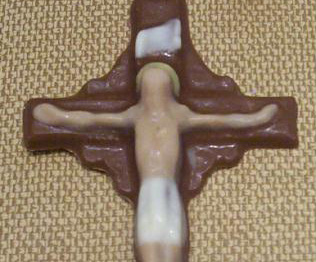A few years ago, I went to one of my favorite shops, For the Love of Chocolate in Carytown, looking for Easter candy for my son – and, if I’m honest, a little something for me, too. They always have tons candy options and pretty colors and unique flavors; and, well they are simply the best chocolate in Richmond. As I was looking through their collection of filled Easter eggs and intricately molded chocolate bunnies, I ran across a basket of chocolate crosses and crucifixes.
I thought to myself, “What?” A chocolate cross?
What a theological conundrum. Am I supposed to enjoy a symbol of suffering, a device for execution, by dipping it in peanut butter? What part body of Christ on the crucifix do I break off and eat first? The head? The parts with the chocolate nails? Did a priest bless chocolate Jesus so that transubstantiation can occur? Seeking answers, I flipped it over to read the ingredients and discovered that these chocolate crosses and crucifixes were also kosher. That opened up a whole other can of theological worms.
I don’t want to be a stick in the mud, but there’s something about a confectionary cross that makes me cringe. It misrepresents what the cross really means, and it turns Lent into a sprint toward an Easter basket. Lent is the forty days prior to Easter. It’s a time of sacrifice and reflection on our humanity. From the early church until the last century or so, Lent was a time of fasting for Christians. Today, those of us in the U.S. who still practice Lent generally don’t do anything so drastic as fasting. We give up a bad habit or some thing we enjoy, like Facebook, television, wine, hamburgers, or, ironically, chocolate. I didn’t celebrate Lent as a child because I was raised Baptist, so maybe my choice to celebrate it now makes me more sensitive, but I feel like we rush toward Easter morning, forgetting what it takes to get there. It’s as if Lent is like having to eat our vegetables so we can get to our dessert; going to bed early Christmas Eve so we can get to our presents on Christmas morning faster; patiently waiting in a long line before being admitted to Resurrection Disneyland.
I’m here to tell you that Lent is not the journey to Easter. Lent is the journey to the cross.
Easter dresses advertised as early as New Year’s Day and aisles of Easter candy for sale before Valentine’s tend to rush us toward resurrection, without pausing to consider what it means to be brought back to life. It means dying first. And death doesn’t make a pretty window display.
The Lenten journey to the cross isn’t a journey of hope, like Advent, it’s a plodding resignation toward the inevitable. If Jesus is true to his calling as the Christ, he cannot avoid the cross, and if we call ourselves Christians in his name, neither can we.
Today’s Gospel story is one of many opportunities on the road to the cross that Jesus has to turn the tide, change course for another, more practical destination. Two Greeks happen to be in Jerusalem for the Passover festival, either to worship as Gentiles converted to Judaism or simply to observe the ancient rituals as a cultural curiosity – we don’t know why they are there. Jerusalem is abuzz about Jesus, who just a few weeks earlier raised his friend Lazarus from the dead. It was a sensational story with lots of witnesses, many still talking about it in Jerusalem. Some of the witnesses were so concerned with what they saw, they went to the Jewish religious leaders, worried that Jesus’ popularity was a threat, not only to their faith but also to their nation. As a result, the Pharisees determined that both Jesus and Lazarus should die.
Their determination wasn’t a secret. Jesus knew he was a marked man. And still, he goes to Jerusalem. The city is filled with Passover crowds and the word spreads that Jesus is almost there, so throngs of festival-goers line the streets in an impromptu parade with palms, shouting accolades, and calling Jesus the King of Israel – all but spitting in the face of their Roman rulers. This reception creates a threat to Rome, deepening the threat to the Jewish leaders. But it also creates an opportunity for Jesus.
Jesus could take his popularity straight to the throne. He’s got political capital, he’s got the will of a people crushed by the Roman government, and he’s got the emotional potency of the Passover – a time when the Jewish people celebrate their liberation from foreign overlords. Revolutions have toppled monarchs with less going for them.
Now Jesus has the interest of the Greeks. They are outsiders to Jerusalem, culturally and intellectually respected abroad. Like everyone, they want to see Jesus – the popular Jesus who heals people, Jesus the inspirational public speaker. All he had to do was meet them, speak with them. It would take very little to bring them to his side. After all, isn’t that what he did with the Samarian woman at the well a few chapters earlier? The Roman official who’s servant he healed? If the Jewish leaders wouldn’t listen to him, people in high places would. All he had to do was speak with them and heal a few people. There are always people in need of a good word. There are always people in need of healing.
But the path of Lent is not to a throne or a microphone or a guest appearance on Dr. Phil. The path of Lent is to a cross. So when Philip and Andrew let Jesus know that a couple of Greeks would like to meet him, Jesus takes this opportunity to remind his disciples and anyone in earshot that a “meet and greet” is not why he’s in Jerusalem. Somehow Jesus knows he’s going to die there, and rather than build a base of support in order to protect himself, he leaves them all to go into hiding so he can prepare for the inevitable.
Many revolutionaries in the last two centuries, like Jesus, worked hard to right wrongs, change the system, and bring peace: Abraham Lincoln, Mahatma Gandhi, Martin Luther King, Jr. Each one of them knew what it took to create change. Each one of them knew a cross awaited them. All of them predicted their own deaths, they knew when their hour had come, and rather than circumvent it, they stayed steady on the path to the cross.
If the cross is anything, it is truth. Our Lenten path is the path to the truth that we all have a cross – and it isn’t made of chocolate. Each of us has an hour that will come.
I think of the funerals I’ve officiated. Thomas was only thirty-five – such talent, and the biggest heart you’ve ever seen. One night that heart just stopped. Zack was quick-witted and funny and loyal to a fault. One day his brain misfired and he had a seizure. He never woke up. He was twenty-nine. Michael was diagnosed with cancer in January and by April he was gone. His last three months were riddled with confusion, anger, sadness, then finally acceptance.
The Lenten path is a reminder that at the end of everything, our cross awaits. So we have a choice: Do we do whatever we can to avoid it, or do we embrace it and make every step of our journey count?
At this point, you all are thinking I’m a fatalist. I promise you, I am not. I’m a realist. Death is hard and it is final. Once they have left us, we do not embrace our loved ones again in this world. Jesus knew this. We can tell ourselves that Jesus magically knew everything would all turn out okay in the end. He raised Lazarus, so he knew his turn was next. After all, he had his divinity going for him. But that’s too easy. I don’t believe Jesus went to his cross knowing that three days later he’d be hanging out with his friends again. If we believe in the incarnation, that Jesus experienced every bit of humanity – our humanity – then Jesus had to experience death the way we do: desperate, angry, remorseful, confused, afraid. The God who is willing to become one of us, must be willing to experience the very thing that makes us human: our finality.
I am a realist. But I am also a Christian. And while we walk the path of the cross during Lent, Christians are not defined by that cross. We are Easter people. Our story is one of hope because if the path leads to the cross, then the cross is the key that opens the door to resurrection. Just as the cross is truth, so is resurrection.
Jeremiah claimed resurrection while sitting in a burned out city, left behind by conquerors who took the best and the brightest children, parents, brothers, sisters back to their country as exiles. Israel tried to change course three times in three rebellions against the nations that ruled them, only to be gutted and left to their own ruin. Even in the shadow of the decaying temple, Jeremiah promised a time when God would reconcile to Israel, when Israel would know God, and everyone would come home again.
I know resurrection is truth because I’ve experienced it. I’ve seen enemies become friends. I’ve seen children reconcile with their parents. I’ve seen addicts holding on for dear life to their sobriety. I’ve seen cancer beaten into remission. After months of brown and grey landscapes covered with ice, I see daffodils blooming next to my doorstep.
Resurrection is truth.
Most recently I discovered that truth where I never expected it: my school. I was one of the last students to enter the Presbyterian School of Christian Education as its own institution, and I was the first graduating class after the school federated with Union Theological Seminary in 1997. I was a student at both schools, so I saw the anger and bitterness from both sides as the two schools merged. I was on the staff of Union-PSCE when bit-by-bit, the faculty and staff of PSCE were let go and the Christian Education program floundered.
But just last year, the newly named Union Presbyterian Seminary, which still houses both schools, asked me to help with the ATS-PSCE Centennial Celebration this past November, celebrating the 100-year anniversary of the Christian education school. My job was to tell the ATS-PSCE story through the pictures found in the archives. I sorted through photos and videos from the last hundred years. Fresh faces from decades ago, so young and filled with hope and excitement, reminded me that something beautiful was lost. Some of the students whose photos I put in order were only a few years older than my son. Most of them are gone now. These women and men were the bedrock of the school, this school I watched slip away. They looked back at me from across the century as if to say our work was in vain, our dreams are gone.
But a funny thing happened during the four days we celebrated in November. Four hundred alumnae and alumni showed up on the campus of UPSem, and we told stories and danced and hugged and worshiped – and suddenly the dream wasn’t dead anymore. It had been living in us all along. All we needed was the chance to be reminded of what we were and what we can become even still. Energy we hadn’t felt in fifteen years opened the hearts of everyone on campus, as if someone had opened a window, fresh air blowing away the dust and sunshine warming our souls so we can live again. PSCE is not nor will it ever be the same as it was, but with a new curriculum and two new professorships created for the Christian Education program, it is resurrection.
The truth of resurrection is that we are not what we were before. Israel was not the same when the exiles came back home. Death, loss, separation – it changes us. We don’t always want change. We want to skip over the cross and dive right into the Easter basket. But then we’d miss the opportunity to become more than we are. We’d miss the life-transforming truth of resurrection.
We can’t claim to be Easter people unless we walk the path of the cross. I wish it could be otherwise. I wish I could promise you a chocolate cross, but I can’t. I wish I could promise that with change, everything will be coming up roses. I can’t. I can promise this, however: Jesus walked this path and continues to walk this path with each and every one of us. We may not know how our journey ends, but we know who holds our hand. He is Emmanuel – God with us. And because we have a God who walks with us, let us in turn walk this journey with each other, holding hands, embracing, supporting each other on the way – for the road to the cross is treacherous, it is easy to get lost, and we must make every step count.
Amen.
Preached at the Hermitage on March 22, 2015 for Lent 5B. Scriptures that day were Jeremiah 31: 31-34 and John 12:20-33.



Beautiful!